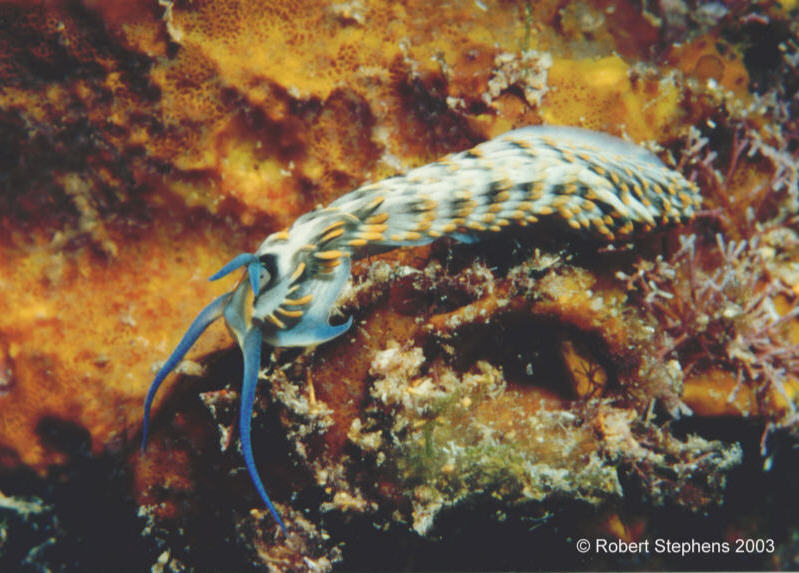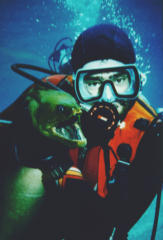 |
Cerberilla tanna
Photo courtesy of Robert StephensSpanish Wells Bahamas, 1986.
Cerberilla tanna (Tentative Identification)Marcus & Marcus 1960
Paul Humann and Ned DeLoach's second edition of Reef Creatures Identification contains a photo of a spectacular Cerberilla photographed at St Vincent (page 308-309) which we have not been able to put a name on. This species is shown here in Robert Stephens photo from the Bahamas.
Its not everyday we get to see a species as flamboyantly colored as this one, even though that does seem to be the name of the game in sea slugs. As we have discussed so often before this bright coloration is aposomatic, or a warning strategy advertising that it is distasteful or even poisonous if eaten. Although we really have no such evidence for this, it is reasonable to assume that because Cerberilla feed on sand-dwelling sea-anemones and sequester nematocysts in the tips of their cerata, this species is warning potential predators of this armament.
Some discussion about this species has appeared on Bill Rudman's Sea Slug Forum recently after Bill received a photo of the beast from West Palm Beach, Florida (photo by Jeff Hutchinson). The spectacular blue and yellow marking should have made the species a drop in the bucket to identify, but as you would have it, that was not the case. Bill feels that this animal most closely matches a Caribbean species described by the Marcus' as Cerberilla tanna . Their description was written from a faded preserved specimen, but they did mention "an orange-brown spot on the outer surface of many, not all, cerata under the cnidosac." We have not been able to look at the internal anatomy of the specimens photographed by Humann, Hutchinson, or by Stephens, here, to confirm this however, so we all consider this a tentative ID.
Linda Ianello, another avid Branch photographer, diving the very same site as Hutchinson, only a few days later, has documented another Cerberilla, here-to-fore unidentified. Rudman , surmises that this individual is a juvenile Cerberilla tanna because "the black markings around the head of Linda's animal persist in Jeff's, and as we can see in Cerberilla incola black spots on the cerata can change into a pair of black lines." I tend to agree.
Caribbean divers be on alert - we need a preserved specimen of this critter to establish its absolute identity.
Danville, Calif
May. 2003
Reference:
Marcus, E. & E. Marcus. 1960. Some opisthobranchs from the northwestern Gulf of Mexico. Publications of the Institute of Marine Sciences, University of Texas, 6: 251-264.
Robert with friend "Kermit"

During these years over two dozen nudibranchs and slug found their way to me. R. Tucker Abbott noted conchologist from the Smithsonian Institution and the Delaware Museum of Natural History, was a guest of mine a couple of times. One of the visits I persuaded Dr. Abbott to give the school children of Spanish Wells a slide presentation which was unbelievable. The late Dr. Kerry Clark has also visited Spanish Wells, hearing of his passing was very upsetting. Jeff Hamann of El Cajon, California also has been to Spanish Wells in search of nudibranchs, and my wife acted as his guide, In 1991 my wife Tammy Jo and I left Spanish Wells with many fond memories.
You can drop Robert a note at rstep2@bellsouth.net |
